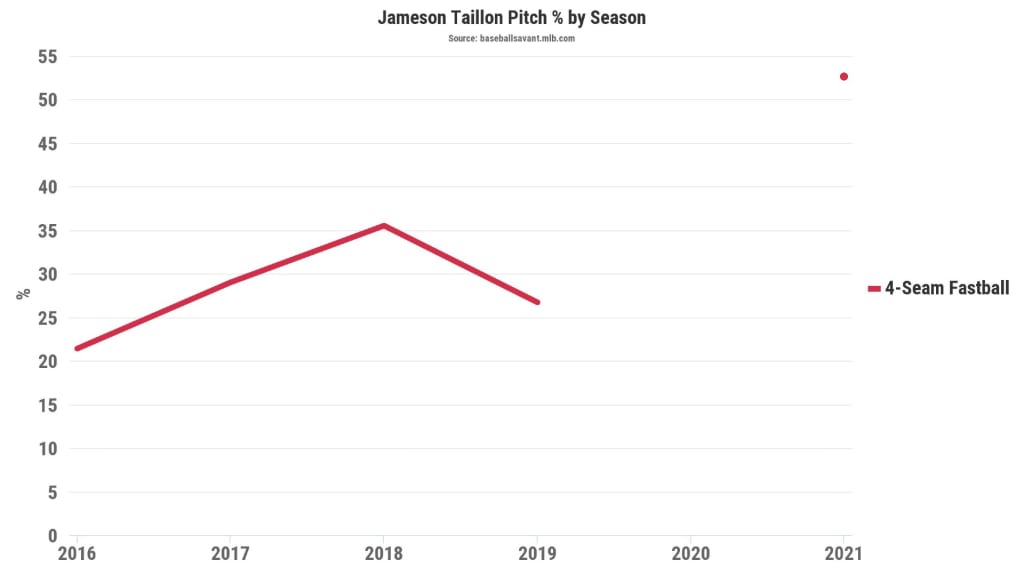From the uniform to the throwing motion to the repertoire, a lot has changed for Yankees right-hander Jameson Taillon in 2021.
Have these changes been for the better? Well, after missing all of 2020 while recovering from his second Tommy John surgery, the 29-year-old has a 5.06 ERA, the highest of his career. Opponents have slugged .463 with nine home runs against him. Meanwhile, the rest of the Yankees’ rotation has thrived, with Gerrit Cole, Corey Kluber, Jordan Montgomery and Domingo Germán posting a collective 2.93 ERA.
But after Kluber went down with a shoulder injury that could keep him out at least two months, Taillon has become increasingly important to New York’s chances of winning a division that has turned into a four-team race thanks to the resurgence of the rival Red Sox.
Fortunately for the Yankees, Taillon has provided reasons to be optimistic about his performance.
He tossed five shutout innings against the White Sox in his most recent outing, extending New York’s starting pitcher scoreless streak to 35 innings. (It ended at 37 1/3, the second longest in franchise history, according to the Elias Sports Bureau.)
Mastering hitter-friendly Yankee Stadium hasn't been an issue for Taillon, whose ERA over five starts in the Bronx is 2.42, compared to 9.18 in four road starts. He'll face the Rays at home on Monday, looking to get the Yankees back on track after a three-game sweep at the hands of the lowly Tigers.
While Taillon’s actual ERA is over 5.00, his expected ERA, which is based on quality of contact, strikeouts and walks, is 3.64, and his “unlucky gap” of 1.42 runs between his ERA and xERA is one of the 25 largest figures in MLB.
The Yankees acquired Taillon for four players in a January trade with the Pirates. Like several other pitchers who have exited Pittsburgh in recent years, Cole included, Taillon has ditched his sinker in favor of throwing more four-seamers, which has led to a spike in strikeouts. (Also fly balls, which we’ll get to in a minute.)
This chart shows his four-seamer usage by season. The line breaks because Taillon didn’t pitch in 2020, but you can see the red dot representing this season’s four-seamer usage is over the 50% mark (52.6%, to be exact). His previous high was 35.5% in 2018.

From 2016-19, Taillon’s strikeout rate was 21.5%, slightly below the MLB average (22%) in that span. In 2021, he’s struck out 27.9% of the batters he’s faced, nearly four percentage points higher than the MLB average. The righty has used his four-seamer to collect 35 of his 50 strikeouts.
Take one look at his four-seam fastball heatmap and it becomes obvious what his strategy has been with the pitch this season: locate it up in the zone.

Fastballs with higher spin rates can better resist the effects of gravity, giving them what seems like a rising effect. Taillon's fastball spin rate ranks in the 82nd percentile. His four-seamer averages 2,446 rpm, well above the MLB average (2,319 rpm). Although his four-seamer “rise” isn’t elite, it ranks in the upper third in inches of rise above average when compared to four-seamers thrown with similar velocity and extension.
In general, high-spin fastballs thrown up in the zone tend to get more whiffs (misses/swings), and that’s exactly what the data shows for Taillon.
Highest four-seam fastball whiff rate, 2021
Min. 150 swings on four-seamers
Jacob deGrom: 36%
Lance Lynn: 35.7%
Max Scherzer: 33.5%
Freddy Peralta: 33.1%
Carlos Rodón: 32.2%
Jameson Taillon: 32.1%
Liam Hendriks: 31.6%
Michael Kopech: 31.4%
Rich Hill: 31%
Gerrit Cole: 30.5%
Taillon’s new throwing style also likely has had something to do with his four-seamer success. The righty revamped his motion in the offseason, focusing on using his legs more and adopting a shorter arm swing.
“You hear as a kid, ‘Throw with your legs.’ Well I had never been properly taught what that really meant,” Taillon said in January. “So now I’m actually activating my legs in a way that takes some pressure off my arm. By cleaning up the way my lower body moves, it shortened up my arm path. So I used to have this really long whippy arm motion, and now it’s much closer to the body."
With his new motion, Taillon is getting much more extension, which quantifies how many feet from the rubber a pitcher releases the ball. From 2016-19, Taillon’s average extension on four-seamers was 6.3 feet. He’s increased it to 6.8 feet in 2021, which means he’s releasing the ball six inches closer to home plate.
The added extension undoubtedly has played a part in Taillon's rise in four-seamer whiff rate from 20.5% over his first four seasons to 32.1% in 2021, a year in which he's displayed slightly diminished velocity.
Now, about those fly balls. A byproduct of throwing so many four-seamers in the upper portion of the strike zone is an increase in air contact when batters hit the ball.
Taillon has been susceptible to barrels (batted balls with the optimal combination of exit velocity and launch angle, typically resulting in extra-base hits), allowing a career-high 11.3% barrel rate this season. His average launch angle has jumped to 20.5 degrees, also a career high. (His average launch angle from 2016-19 was 9.0 degrees.)
However, it’s notable that his sweet-spot rate (the percentage of batted balls in the launch angle sweet-spot zone of 8-32 degrees) hasn’t jumped that dramatically. It was 34% from 2017-19; it’s 34.8% this year.
That means he’s allowing a lot of fly balls that aren’t in the sweet-spot zone, which is good for Taillon. Batted balls with a launch angle of 33 degrees or higher have yielded an MLB-wide batting average of .096 this season.
In terms of allowing well-struck contact, Taillon has yielded a hard-hit ball (95+ mph exit velocity) on only 12% of the total swings against him, one of the best rates in the Majors and virtually identical to Cole’s mark.
So while Taillon does have a lofty barrel rate, the fact that it isn’t tied to a trend of allowing a ton of hard contact in general is promising.
It’s also important to remember that, before this season, Taillon had not pitched in a Major League game since May 1, 2019. Plus, he had to get used to an entirely new way of pitching. Mistakes were inevitable.
Taillon definitely took some licks early on, but getting off the mat when he's knocked down is what he does. He's dealt with much bigger obstacles than this, making it back from two Tommy John surgeries and surviving cancer.
As Taillon heads into his start against the Rays, things appear to be looking up for the righty. His outing against the White Sox was the first time all year he didn't allow a single barrel in a game.
Cole is still the Yankees' most important pitcher, of course, but in the wake of Kluber's injury, Taillon could prove to be the team's X-factor.
